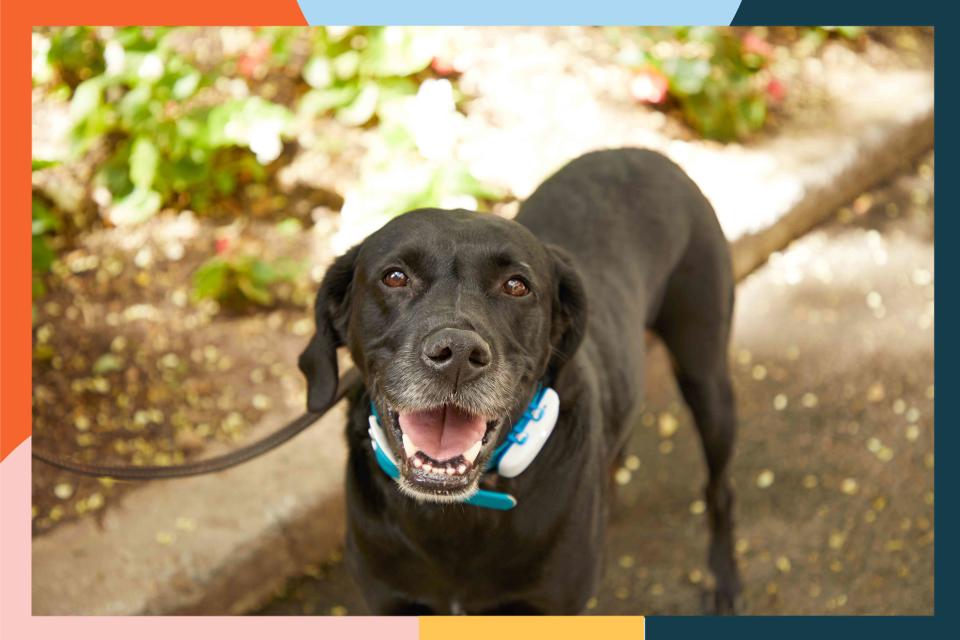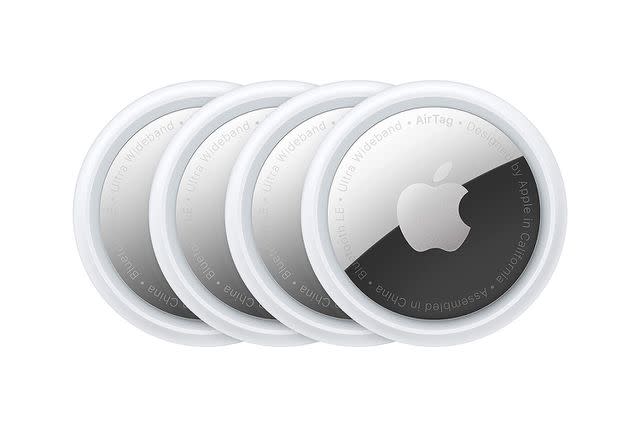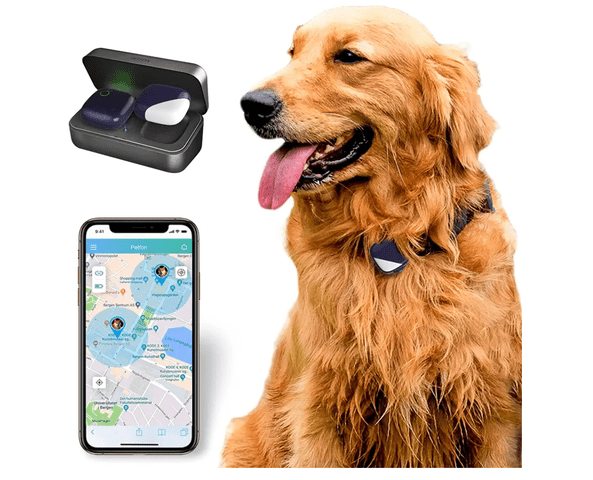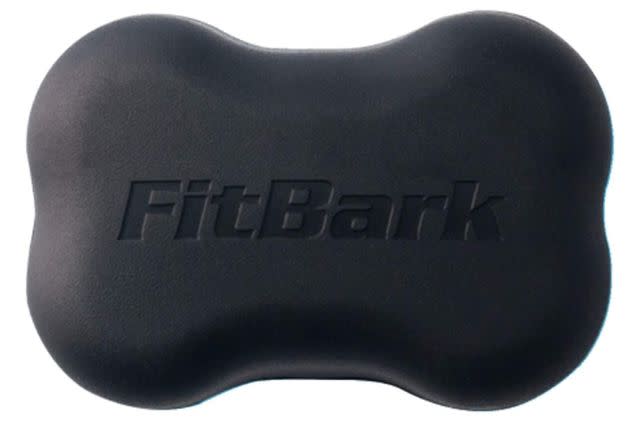The 6 Best Dog GPS Trackers of 2024, Tested and Reviewed
Dotdash Meredith and Yahoo Inc. may earn commission or revenue on some items through the links below.
The Petfon 2 Smart Tracker is our top pick

People / Tamara Staples
There’s no worse feeling than when your dog goes missing — something celebrities like Paris Hilton have even experienced. If you worry about your furry friend wandering off, you can give yourself peace of mind by outfitting them with a GPS tracker. The best dog GPS trackers provide real-time location updates directly to your phone, allowing you to quickly find your pet and bring them home safely if they wander out of your yard or get lost while out hiking.
“GPS trackers have a lot of benefits,” explains Nicole Ellis, a certified professional dog trainer with Rover. “There is the obvious one of tracking our pets in the event they should get out, but there’s more than that. Quite a few GPS trackers will give you insights into your dog's health, from how much exercise they are getting to the amount of itching and licking going on.”
When you’re looking at different GPS trackers, you’ll want to consider things like the size of the tracker, battery life, tracking range, and whether it requires a monthly subscription. There is a wide range of products to choose from for your pet, and we tested more than a dozen of the top-rated dog GPS trackers to see which ones performed the best. We have to be honest: We have yet to come across the perfect dog GPS tracker, and we've outlined the pros and cons in detail below. We take our pet's safety seriously, and if you're reading this, you likely do, too.
These are the best dog GPS trackers that PEOPLE Tested.
Best Overall: Petfon Petfon2 Smart Tracker

Pros
The live GPS location updates are accurate and displayed on a detailed map that includes street names.
The app includes training videos that are suitable for all ages.
The battery can last for several days if you don’t use the live tracking mode.
This tracker doesn’t require a monthly subscription fee.
Cons
The tracker would occasionally turn itself off during use, and the app doesn’t notify you.
If you don’t mind spending a little more upfront, the Petfon 2 is a non-subscription option that performed well during our tests, earning it high all-around scores and the top spot as our best overall pick. It has a compact design that can easily be attached to your dog’s collar, and we were able to set it up in just a few minutes. We especially liked that there are comprehensive training videos that explain the different features of the tracker, and the brand has gone to lengths to ensure they’re accessible for users of all ages.
When we tested this tracker, it displayed accurate locations, and the map was labeled with street names and other details that make it easier to pinpoint your lost pet. The tracker itself will also light up and/or play a ringtone to help you find it, and we like that you can customize both of these settings by selecting your preferred color and tune. The Petfon app also keeps track of data such as your pet’s daily steps, minutes of activity, and minutes of rest, and it keeps an accurate history of your pet’s location.
While the brand lists this tracker’s battery life as eight to 16 hours, we found that it lasts significantly longer if you don’t frequently use the live tracking mode. In our testing, it was able to go 10 days before needing to be recharged, but we did notice that it occasionally shut itself off without notifying us. When this happened, we often didn’t realize the tracker was off until we opened the app, and this could pose an issue if it happens while your dog is wearing the device.
Dimensions: 42 x 42 x 18 millimeters | Weight: 0.97 ounces | Battery Life: 8-16 hours | Waterproof: No | Subscription: None
Best Budget: Apple AirTag 4-Pack

Pros
The tag paired with our iPhone in less than 30 seconds.
The AirTag was able to withstand being submerged in water for over a minute.
This tracker is one of the smallest and lightest options we tested.
This tracker doesn't require a subscription.
Cons
Once the tracker is out of range of your phone, its accuracy suffers.
AirTags can only be used with Apple phones, so this isn’t an option for Android users.
After thorough testing, the Apple AirTag is another one of our top recommendations for a GPS tracker thanks to its ease of use, affordable price, and compact design. These round tracking devices are just over 1.5 inches in diameter and extremely lightweight, making them well-suited for both large and small dogs, and there is a wide selection of accessories you can use to attach the AirTag to your dog’s harness or collar. The AirTag is also rated IP67 so it's splash, water, and dust resistant and can handle being up to one meter underwater for as long as 30 minutes. Each AirTag is reasonably priced, and it’s one of a few products that doesn’t have a monthly subscription fee, making it the best budget-friendly choice.
We loved how easy it was to pair the AirTag to an iPhone. All you have to do is place the tag next to your phone, and it will sync up in a matter of seconds. It’s simple to operate using the Find My app, and it has the longest battery life of all the trackers we tested, lasting up to a full year. This is perfect if you want to attach the tracker to your dog’s collar and forget about it, as you won’t need to constantly take it off for charging. It's also perfect to slip inside a dog backpack carrier when traveling.
Regarding accuracy, the AirTag was pretty good but not perfect. (You’ll see that none of the trackers we tested wowed us with their accuracy.) If the tracker is within Bluetooth range of your phone, which is roughly 33 feet, the Precision Tracking feature will provide an exact location and allow you to ping the AirTag. However, we found that once it’s out of range of your phone, the accuracy suffers a bit as your phone works to locate it.
While it is one of our top picks, that’s not to say the Apple AirTag is a perfect solution. The biggest downside of this tracker is that it’s only available for iPhone users — the tags can’t be paired with Android or Google phones, which may rule it out for many people. Additionally, because of how it works, this GPS tracker is most effective and accurate in locations where there are a lot of iPhone users around — a.k.a. a city or busy neighborhood. When the tag is out of your phone’s Bluetooth range, its signal is tracked by other nearby Apple devices, which confidentially transmit the location of your AirTag to iCloud. Essentially, you’re relying on other people’s iPhones to pinpoint your dog’s location. If you’re in a more rural location, such as a hiking trail, with no one else around, the long-distance tracking abilities are essentially rendered useless.
The Apple AirTag was previously our top pick for a dog GPS tracker, but due to the Apple software limitations, it was outranked during this round of testing. However, for the affordable price and ease of use, we think this is still an excellent choice for iPhone users, particularly those who want to spend their money on other essential dog supplies.
Dimensions: 1.6 x 1.6 x 0.1 inches | Weight: 0.39 ounces | Battery Life: 1 year | Waterproof: Yes, IP67 | Subscription: None
Best for Hiking: Petfon Pet GPS Tracker

Pros
The tracker is compact and doesn’t seem bulky when attached to a collar.
This tracker has a range up to 3.5 miles in open outdoor spaces.
When it has a strong connection, the tracker provides frequent and accurate location updates.
Cons
The battery life depletes quickly — it dropped 6 percent in the first 10 minutes of use.
This tracker sometimes loses its connection to the phone, sometimes for several minutes at a time.
If you’re only planning to use your GPS tracker during short outings with your pet, the Petfon GPS Tracker is a solid no-subscription option. It does have a higher upfront cost, but it offers real-time GPS tracking with a range of 3.5 miles in open outdoor areas. (In dense city areas, the range drops to 0.65 miles.) The tracker comes with a band that you can attach to your dog’s collar, and we liked the sleek, compact design, which isn’t overly bulky, even on smaller dogs.
The Petfon GPS Tracker has the shortest battery life of the products we tested, lasting just eight to 16 hours per charge, but it does come with a portable case that can recharge the tracker up to three times. We think this tracker would be well-suited for activities like hiking, especially since it works best in open outdoor environments, but if you want it for daily use, you’ll likely need to charge it every day.
In terms of accuracy, it was one of the better options we tested. It does occasionally lose connection with the app, but overall, we found that its updates were more frequent and accurate than other trackers. The device has a light that you can turn on to help locate your pet at night, and while there’s also a feature that lets you ping the tracker, we found that it’s too quiet to be much help.
Dimensions: 1.7 x 1.7 x 0.6 inches | Weight: 0.97 ounces | Battery Life: 8-16 hours | Waterproof: No | Subscription: None
Best for Tracking Activity: FitBark GPS Dog Tracker (2nd Generation)

Pros
The tracker connects to three cellular networks for better GPS coverage, and its live tracking data is very precise.
The FitBark app collects health data, and it sends notifications if your pet hasn’t reached their daily goals.
The device is smaller than most and fits comfortably on small-breed dogs.
Cons
The tracker attaches to your dog’s collar with zip ties, which have to be cut off and replaced if you need to remove it.
It took several tries to connect this GPS tracker to our Wi-Fi network.
Of all the GPS trackers we tested, the FitBark GPS 2nd Gen offered some of the best activity-tracking features. In addition to keeping tabs on your dog’s location, this device tracks a variety of other health metrics, including your dog’s daily calories, activity time, sleep score, and miles traveled, and you can even link the app to Apple HealthKit and set goals for yourself and your dog. Because the tracker is able to connect to three different cellular networks, we also found that it provides extremely accurate tracking information.
The FitBark GPS is one of the smaller trackers we tested, and it wasn’t too cumbersome for our 13-pound dog. However, we didn’t like that the tracker must be connected to your dog’s collar using two zip ties — it took some trial and error to get the tightness right, and you also have to cut and replace them every time you need to take the tracker off. The good news is that the battery lasts for up to 60 days per charge, though it depletes much faster if you use the live tracking mode, which refreshes its location once per minute.
Dimensions: 1.85 x 1.18 x 0.59 inches | Weight: 16 grams | Battery Life: Up to 60 days | Waterproof: Yes | Subscription: $9.95/month
Related: Dog Talking Buttons Are the TikTok-Viral Way to Communicate With Your Pooch
Best for Large Dogs: Link The Link Smart Pet Wearable

Pros
The tracker provides extremely accurate location data on Google Maps, making it easy to pinpoint your dog’s location.
The app logs activity data and can even differentiate between running and walking.
The app is user-friendly and easy to navigate — it’s similar to the Fitbit app.
Cons
The tracker is fairly bulky.
For larger dogs, the Link Smart Pet Tracker is another worthwhile option. While the tracker itself is somewhat bulky, we found that this device offered extremely precise location data — it could even tell us what room of the house the dog was in! Plus, it displays the tracker’s location on Google Maps, allowing you to see street names and other landmarks to find your dog faster.
This tracker also captures a variety of additional health data, such as steps, miles traveled, and even time spent walking vs. running. You can also set daily fitness goals for your dog if desired. The app has a very user-friendly design — it reminded us of the Fitbit app — and it’s easy to set up and navigate. The battery on the tracker itself only goes down about five percent on an average day, so it really only needs to be charged once a week.
The Link Tracker is fairly expensive upfront and also includes a monthly subscription fee, but like most devices, you get a discount if you opt for a longer contract. Your subscription also includes a few additional features, such as 24/7 access to televet services and discounts on products and services from the brand’s partners.
Dimensions: 2.25 x 1.4 x 0.8 inches | Weight: 1.1 ounces | Battery Life: Up to 14 days | Waterproof: Water-resistant, IPX8 | Subscription: $9.99/month
Best for Small Dogs: Tractive GPS Tracker for Dogs

Pros
As long as it has a GPS signal, there’s no range limit on the tracker.
The rubber straps make it easy to attach/detach from your dog’s collar, while still keeping it securely in place.
The app recorded location history and accurately plotted the route we used during testing.
Cons
The default setting only provides live tracking updates every five minutes, but this can be adjusted in the app’s settings.
Some GPS trackers are fairly bulky and might be too cumbersome for small dog breeds, which is why we like the Tractive GPS Dog Tracker. This product is more compact than many other options we tested, and it comes with a handy rubber clip that makes it easy to remove from your dog’s collar for charging. It has an affordable upfront cost, but you do have to pay a monthly subscription fee to operate this tracker. The good news, however, is that it has unlimited range, so you can locate your pup no matter how far they’ve wandered.
During testing, we found that the Tractive wasn’t the best option in terms of real-time updates, sometimes struggling to find a signal, but it did create an accurate location history map. It’s automatically set to provide a location update every five minutes, but we liked that you can adjust this setting if your dog ever gets loose and receive updates more frequently — as often as every two to three seconds. The app also allows you to create virtual fences and will send you notifications if your dog wanders outside of them, and the tracking unit itself is completely waterproof, so you can leave it on your dog's life vest when he goes swimming.
Dimensions: 2.8 x 0.65 x 1.13 inches | Weight: 1.2 ounces | Battery Life: 7 days | Waterproof: Yes | Subscription: $13/month
Things to Consider Before Buying a Dog GPS Tracker
Data Source
There are several different ways that GPS trackers gather location data. Some use cellular networks, some use GPS satellites, and others use both. “Depending on the location of your dog’s activities, collars that operate off cellular towers may not be an option, so you might need to consider one that runs off satellite,” explains Kait Hembree, Head of Training at GoodPup. “Collars run off cellular towers are great for helping find lost dogs, but if you need to be able to monitor the movement of your dog, then a satellite GPS would be the better option.”
There are also some trackers, such as the Apple AirTag, which rely on Bluetooth connections to smartphones to provide location information. These devices are only effective in more populated areas, which is important to keep in mind as you shop.
Range
Your GPS tracker will only be effective if it's within range of your phone — some products have an unlimited range, while others only work up to a few miles — and you’ll want to select a product based on your dog’s habits.
If your dog tends to take off after wild animals, you’ll likely want a product with a longer range, such as the Tractive GPS Tracker for Dogs, which has an unlimited range. On the other hand, if your dog tends to just wander around the neighborhood, a shorter-range device might suit your needs.
For those who travel with their dogs, it’s also important to note that not all devices work outside the US: “When I filmed The Pack for Amazon, we used GPS collars just in case a dog should get loose while filming, but we were limited to devices as not all work outside of the United States,” explains Ellis. “For example, Whistle trackers work in the US and Canada, while Tractive works pretty much worldwide.”
Subscription
In addition to the initial purchase price, some dog GPS trackers have a monthly (or yearly) subscription fee, typically between $10 and $20 per month, to access their GPS abilities. If you don’t want to pay a recurring fee, you may want to look for a subscription-free option, such as the Apple AirTag or the Petfon 2 Smart Tracker.
Battery Life
The battery life on dog GPS trackers can range quite dramatically: Some need to be charged every day, while others can be used for a full year before needing a new battery. You’ll want to think about how you plan to use the dog GPS tracker to find the best fit for your needs. If you want to simply attach it to your pet's collar and leave it there, look for a product with a long battery life. However, if you only plan to use it during short outings, such as daily hiking trips, a shorter battery life might not be a big deal.
Features
Some of the dog GPS trackers we tested are specifically designed for pets, while others, like the AirTag, are general GPS trackers. Dog-specific GPS trackers often have additional features that you may be interested in, such as activity or sleep tracking. Some products also have a geofencing feature, which sends you an alert if your dog exits a designated safe zone, such as a dog pen.
“Through activity tracking, we can notice trends,” says Ellis. “For example, if your dog hasn't been as active lately, maybe she is not feeling well or sick. Some of them also give us goals, providing that extra motivation we may need to get out and walk our dogs, spend time together, and get them outdoors.”

People / Tamara Staples
Related: The 14 Best Calming Dog Beds of 2024
How We Tested
Accuracy: We’ve conducted two different rounds of testing on more than a dozen of the most popular dog GPS trackers. After setting up each tracker, we worked in pairs to test the device’s accuracy, having one person walk a designated path while the other monitored the app. We also tested each of the tracker’s features to see if they were truly waterproof, how loudly they ping, and so on.
Performance: To see how each dog GPS tracker performs in real-life scenarios, we also gave each one to a dog owner and had them use the device for several weeks during their day-to-day routine to pinpoint the strengths and weaknesses of each product. We also asked each owner to evaluate whether they felt the upfront price and monthly fees were worth the expense.
Overall Value: After all our testing was complete, the dog GPS trackers were then rated for ease of setup, accuracy, functionality, design, and value.
Frequently Asked Questions
How do dog GPS trackers work?
In general, dog GPS trackers work by connecting to nearby GPS satellites, which send the tracker’s location coordinates to your phone. Some trackers can also use Wi-Fi networks, cell towers, and/or Bluetooth connections to track your pet’s movements.
How long does a dog GPS tracker battery last?
The battery life of a dog GPS tracker can vary quite substantially. Some products need to be charged every day, while others can be used for several months before needing to be plugged in. Battery life may also depend on how you use the tracker — for instance, certain trackers last longer if the unit is close to the receiver or connected to Wi-Fi.
Do dog GPS trackers work without cell service?
Some dog GPS trackers, including the Petfon GPS Tracker, work without cellular service, but others may not. You’ll want to read your tracker’s user manual for details on whether it will work when your phone doesn’t have service.
Why Trust PEOPLE?
Camryn Rabideau is a freelance writer and product reviewer specializing in home, kitchen, and pet products. In her over six years of experience as a product tester, she's reviewed hundreds of items firsthand, and her work appears in publications such as PEOPLE, The Spruce, and Homes & Gardens. For this article, she consulted two different PEOPLE tests and compared the features, benefits, and uses of some of the GPS dog trackers we tested. She compared these products based on price, size, ease of setup and use, tracking range, and battery life. She also spoke with Nicole Ellis, a certified professional dog trainer with Rover, and Kait Hembree, head of training at GoodPup, to find out what makes an excellent tracker.
Meet Our Experts
Kait Hembree is the head of training at GoodPup.
Nicole Ellis is a certified professional dog trainer with Rover.
What Is PEOPLE Tested?
We created the PEOPLE Tested seal of approval to help you find the very best products for your life. We use our unique methodology to test products in three labs across the country and with our network of home testers to determine their effectiveness, durability, ease of use, and so much more. Based on the results, we rate and recommend products so you can find the right one for your needs.
But we don’t stop there: We also regularly re-review the categories in which we’ve awarded the PEOPLE Tested seal of approval—because the best product of today might not be the best of tomorrow. And by the way, companies can never buy our recommendation: Their products must earn it, fair and square.
In short, PEOPLE Tested provides recommendations you can trust—every day, every purchase.
Up Next: The 11 Best Dog Toys for Tough Chewers, Tested and Reviewed
For more People news, make sure to sign up for our newsletter!
Read the original article on People.

